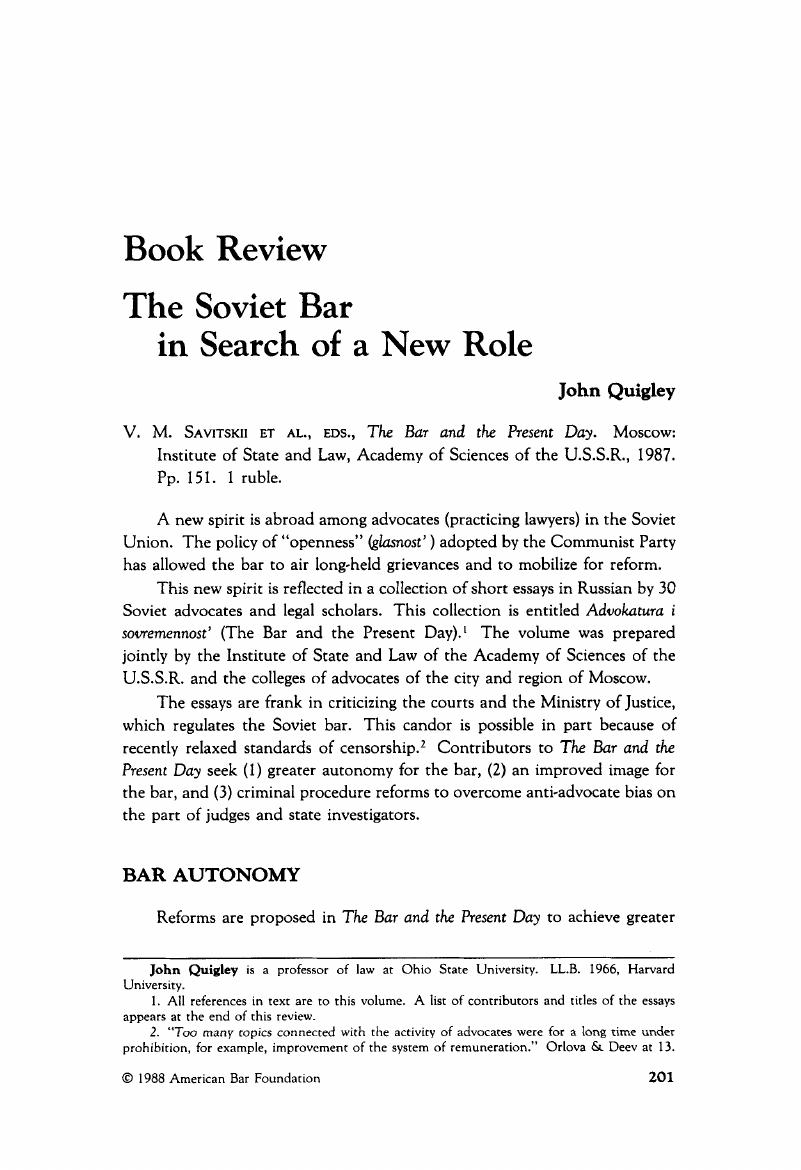No CrossRef data available.
Article contents
The Soviet Bar in Search of a New Role - V. M. Savitskii et al., eds., The Bar and the Present Day. Moscow: Institute of State and Law, Academy of Sciences of the U.S.S.R., 1987. Pp. 151. 1 ruble.
Published online by Cambridge University Press: 27 December 2018
Abstract

- Type
- Book Review
- Information
- Copyright
- Copyright © American Bar Foundation, 1988
References
1 All references in text are to this volume. A list of contributors and titles of the essays appears at the end of this review.Google Scholar
2 “Too many topics connected with the activity of advocates were for a long rime under prohibition, for example, improvement of the system of remuneration.” Orlova & Deev at 13.Google Scholar
3 Law on the Bar of the U.S.S.R., Nov. 30, 1979, art. 3, Vedomosti verkhovnogo soveta SSSR (Gazette of the Supreme Soviet of the U.S.S.R.) (hereinafter “Gazette”), no. 49, item 846 (1979).Google Scholar
4 Law on the Procedure for Appealing in Court the Unlawful Actions of Officials That Infringe the Rights of Citizens, June 30, 1987, Gazette, no. 26. item 388 (1987); also in Izvestiia, July 2, 1987. For analysis, see John Quigley, , The New Soviet Law on Appeals: Glasnost' in the Soviet Courts, 37 Int'l & Comp. L. Q. 172–77 (1988).Google Scholar
5 On Entry into Force of the Law of the U.S.S.R., “On the Procedure for Appealing in Court the Unlawful Actions of Officials that Infringe the Rights of Citizens,” June 30, 1987, Gazette, no. 26, item 389 (1987).Google Scholar
6 Law on the State Enterprise (Combine), June 30, 1987, Gazette, no. 26, item 385 (1987); also in Pravda, July 1, 1987. and Izvestiia, July 1, 1987.Google Scholar
7 Law on Individual Labor Activity, Nov. 19, 1986, Gazette, no. 47, item 964 (1986).Google Scholar
8 Law on the Bar, art. 4, Gazette, no. 49, item 846 (1979) (cited in note 3).Google Scholar
9 Law on the Bar, art. 10, Gazette, no. 49, item 846 (1979). On advocates' fees, see Jean-Guy Collignon, Les juristes en Union Soviétique 20612 (1977).Google Scholar
10 Law on the Bar, art. II. Gazette, no. 49, item 846 (1979).Google Scholar
11 The Association of Soviet Jurists (Assotsiatsiia sovetskikh iuristov) includes members of all branches of the legal profession, not just advocates. Moreover, it functions solely to maintain contact with lawyers abroad, operating within the Union of Soviet Societies of Friendship and Cultural Ties with Foreign Countries, and does not carry out domestic functions.Google Scholar
12 Zubarev at 75–76; Iu. Vvedenskii. M. Degtiarev & V. Zubarev, On Creation of an All-Union Social Scholarly Research Institute of the Bar, Sovetskaia iustitsiia (Soviet Justice) (hereinafter “Soviet Justice”), no. 18. at 28–29 (1986). The authors are presidents of the governing boards of the colleges of advocates of Leningrad City, Krasnodar Territory, and Crimea Province.Google Scholar
13 Vedenskii, V. et al., Soviet justice, no. 18 at 28 (1986).Google Scholar
14 Id.Google Scholar
15 Id. at 29.Google Scholar
16 Murad'ian, E., Civil Procedure: The Need for Reforms, Soviet Justice, no. 13, at 14 (1986).Google Scholar
17 Law on the Bar, art. 5, Gazette, no. 49, item 846 (1979) (cited in note 3).Google Scholar
18 “Legal nihilism” is a reference to the theory that law and the state will die out when Soviet society reaches the stage of communism.Google Scholar
19 Decree no. 15, Plenum of the Supreme Court of the U.S.S.R., On Further Strengthening of Legality in the Administration of Justice, Dec. 5, 1986, para. 9, Biulleten' verkhovnogo suda SSSR (Bulletin of the Supreme Court of the U.S.S.R.) (hereinafter “Bulletin”), no. 1, at 8 (1987).Google Scholar
20 Peter H. Solomon, The Case of the Vanishing Acquittal: Informal Norms and the Practice of Soviet Criminal Justice 16 (Working Paper No. 28, Soviet Interview Project, University of Illinois at Urbana-Champaign, Jan. 1987).Google Scholar
21 Id. at 24.Google Scholar
22 Decree no. 15, para. 4, Bulletin (cited in note 19).Google Scholar
23 Decree no. 5, Plenum of the Supreme Court of the U.S.S.R., On the Practice of Application by Courts of Laws Protecting the Right of the Accused to Defense, June 16, 1978, para. 2, Bulletin, no. 4, at 7 (1978). The constitutional provision is Constitution of the U.S.S.R., art. 160 (Oct. 7, 1977).Google Scholar
24 On reluctance of investigators to pursue lines of investigation suggested by defense counsel, see Dina Kaminskaya. Final Judgment: My Life as a Soviet Defense Attorney 53–55 (1982).Google Scholar
25 Kaminskaya, Final Judgment, at 55.Google Scholar
26 Letter of Presidium of Moscow City College of Advocates, Literaturnaia gazeta, Apr. 23. 1986; also in Libus & Nagornyi at 97.Google Scholar
27 See, e.g. Criminal Procedure Code, Russian Soviet Federated Socialist Republic, art. 47.Google Scholar
28 On reform efforts in Soviet law, see John Quigley, Soviet Courts Undergoing Major Reform, 22 Int'l Law. (1988).Google Scholar
29 See notes 4, 6, & 7 above.Google Scholar




